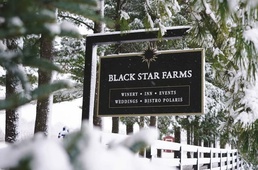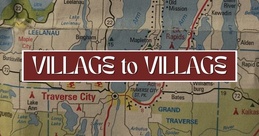MDOT, Others Gamble on Casino Train
Passenger trains could rumble through Traverse City for short hauls
Feb. 2, 2014

A potential rail service from the depot at Eighth St. and Woodmere Ave. to Turtle Creek Casino in Williamsburg is a win-win for commuters and tourists alike, local organizers say.
The Michigan Land Use Institute, the Michigan Department of Transportation and the Great Lakes Central Railroad say they will study the prospect this spring.
"It’s realistic that [Great Lakes Central] could run something a year from now," said James Bruckbauer, policy specialist at the MLUI. "But something that’s functional for tourists and commuters is probably a couple years away."
TRAM OR TRAIN?
Regular passenger train connections in and out of Traverse City petered out in the 1960s. There’s been on-and-off talk in the last decade about bringing something back.
Bruckbauer said the study this spring will be "preliminary" and will hopefully lead to a more nuts-and-bolts analysis.
According to Bruckbauer, a TC-Turtle Creek connection could take different forms,
such as a trolley modified to ride on train tracks or a passenger car hauled by an engine, with several stops along the way, or maybe just one in Acme.
"That’s why we want to put this study together," Bruckbauer said, "because we want to answer those questions."
Another important question is how much it will cost.
"Is this going to cost $2 million or $200 million?" he said. "Let’s figure that out so that we can have some data to move forward."
BREAK FOR COMMUTERS
Bruckbauer sees the route as something that could one day mean more for the region than a ride to the casino for tourists.
"There’s a lot of traffic along US 31," he said. "It’s heavily traveled."
On an ordinary day, the corridor between TC and Acme is congested. In 2015, MDOT plans to overhaul the stretch between Three Mile and Holiday Road with traffic reduced to one lane in each direction.
"Imagine if you’re sitting there in a traffic jam on US 31 and you see this train roll by, right next to you," Bruckbauer said. "Even if it’s going by at just 25 miles-perhour, it doesn’t stop. And it’s heading into town and you could be on that."
A TC-to-Turtle Creek line could also change the way the way the region looks.
"If you’re looking at ways you could create some walkable development around the Acme area, as well as some walkable development around Eighth Street, that could be a good support system for that," Bruckbauer said.
SHARE WITH THE TRAIL
The TC-Turtle Creek connection would run parallel to the TART Trail for most of its route, until TART ends at Bunker Hill Road.
Bruckbauer doesn’t expect a passenger train will be a problem for bicyclists or rollerbladers.
"There are communities where they have the existing passenger rail tracks next to a bike path that are operating trains," he said.
Julie Clark, TART’s executive director, thinks a passenger train would be a fine companion for the trail.
"We’re ahead of our time. A lot of communities that are investing in light rail or commuter lines include a multi-use path alongside," she said. "The TART trail is well positioned to provide this type of system."
DOWNSTATE CONNECTION
A TC-Turtle Creek line would run at the northern end of tracks that stretch to Ann Arbor.
Plans are already underway on the other end for a commuter rail line between Ann Arbor and Howell.
"These projects are sort of bookends and it’s a matter of filling in the middle to establish service
from Ann Arbor to Traverse City," said Tim Fischer, deputy policy director at the Michigan Environmental Council.
The Ann Arbor-TC line needs work, however.
Fischer rode a train from Cadillac to Traverse City in 2010 with others interested in bringing rail to northern Michigan. The track is old and rickety and passenger trains cannot travel above 20 mph.
"It’s actually quite a beautiful trip," Fischer said. "But even for an excursion, that’s pretty slow. Any more than that and you’d have people hurling themselves off of the train."
Upgraded tracks could perhaps handle passenger rail cars traveling at up to 60 mph. It’s just a matter of the state deciding it’s enough of a priority to spend the money, Fischer said.
The tracks are owned by the state and leased to Great Lakes Central.
TC LINK: A PRIORITY
A rail link to Traverse City has already been identified as important by the state.
When the State Rail Plan Final Report of 2011 was developed by MDOT, a rail connection to Traverse City emerged as a top priority.
At 16 public forums around the state, including a crowded meeting at TC’s Civic Center, people were asked to draw their dream rail connections on a map.
"Each map, at each forum, included connecting Traverse City to a southern part of the state in some fashion," the report said. "The southern connection points varied between Grand Rapids and the Ann Arbor area depending on where the forum was held."
The keen interest was also demonstrated by attendance at four open houses about passenger rail hosted by MDOT in September 2010.
Turnout in Traverse City was the strongest with more than 100 people. Negaunee had 23 people; Detroit, 25; and Grand Rapids, 39.
POLITICAL WILL (AND $350 MILLION)
Bruckbauer believes if TC is linked to downstate, it’s most likely going to be through Ann Arbor.
"Starting from scratch, which is almost what you would have to do now between Grand Rapids and Traverse City, is usually cost prohibitive," he said. The tracks between Grand Rapids and Traverse City have been removed to make way for a bike trail.
Bruckbauer said track upgrades that would complete the Ann Arbor-Traverse City link are estimated to cost $350 million.
"It sounds like a lot, but when you compare that to widening a highway, for example, it can look pretty attractive," he said.
MDOT recently estimated that to add one lane each way to US-23 over the dozen miles between Ann Arbor and Brighton would cost $500 million.
"When you look at upgrading the tracks along a 240-mile stretch, as opposed to a 12- mile stretch, and that’s only $350 million, you start looking at those costs and it begins to look more attractive to invest in that rail," Bruckbauer said.
It takes loud popular support to make rail happen, however, said Richard Harnish, executive director of the Midwest High Speed Rail Association in Chicago.
"Just like local communities would demand a highway and fight to get it, if Traverse City wants to get a passenger train, they have to start fighting instead of just saying, "˜Well, maybe someday we’ll get it,’" Harnish said.
Trending

Having a Latte Fun at Mundos
Art? Coffee? Both! Whether you’re a professional barista or just an at-home coffee lover, try your hand at the Lucha L… Read More >>
Lessons in (Wine) Chemistry
Challenge yourself to learn something new this winter…bonus points if that new hobby is A) delicious and B) makes lef… Read More >>
Elk Rapids and GT Commons Kick Off "Village to Village" Winter Campaign
The Village at Grand Traverse Commons and the Village of Elk Rapids are about 20 miles apart. Not a long drive on a summer&r… Read More >>


